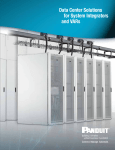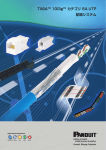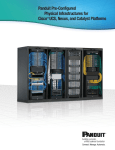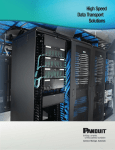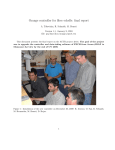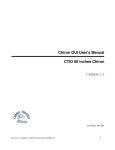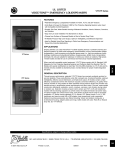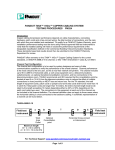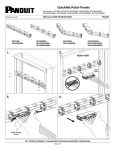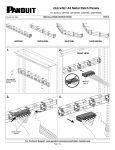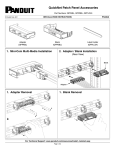Download Panduit QZRBCBCBXX70
Transcript
Application Guide Americas QuickNet™ Copper Cabling in the Data Center QuickNet™ Copper Cabling Systems Quick Reference With the benefits of quick network deployment, assured performance, quality, and easy redeployment, the Panduit® QuickNet™ Copper Cabling System is the perfect infrastructure solution for today’s data centers. Common QuickNet Configurations............. 2 How to Use QuickNet...................... 3 Available in a range of configurations from standard to fully custom, these factory terminated cable assemblies meet the unique needs of data center projects of any scale. How to Configure QuickNet...................... 8 Guide for Measuring QuickNet Lengths...... 11 This guide covers common considerations for using QuickNet Copper systems: QuickNet Standard Part Numbers............ 13 • Applications in the data center • QuickNet termination options & common configurations • Specifying options, measuring for lengths and selecting QuickNet part numbers QuickNet Semi-Custom Part Numbers............ 14 QuickNet Accessory Part Numbers............ 15 QuickNet™ Applications in the Data Center QuickNet can be used for a wide variety of permanent link trunks and equipment cord harnesses that are common in data center architectures such as Middle of Row or End of Row configurations. Overhead In-Row Trunks Overhead Row-to-Row / Pod-to-Pod Trunks Under-floor In-Row Trunks Under-floor Row-to-Row / Pod-to-Pod Trunks Switch Port Harness 1 QuickNet Application Guide QuickNet™ Cable Assembly Components Cable Factory-bundled trunk of six cables. Cable types: • UTP - Cat 6, Cat 6A, Cat 6A SD (Small Diameter) • STP - Cat 6A End 1 End 2 End 1 & End 2 Options UTP Cassette Shielded Cassette UTP Jack Modules End 2 only Options UTP Modular Plugs Unterminated 6-Port Plug Pack Common QuickNet™ Cable Assembly Configurations Cassette to Cassette • Cassette of six modular jacks on both ends of assembly • Typically used in cabinet-to-cabinet permanent link trunks • Installs into QuickNet™ Patch Panels on both ends in common interconnect and cross connect architectures, with cassette enabling quick installation into panels • The most common QuickNet configuration for permanent link trunks • QuickNet Standard Parts for the Americas: UTP Cassette-Cassette, blue cable, blue modular jacks (See p. 13 for more information on standard part numbers) Cassette to Plug Pack / Cassette to Plug • Similar configuration as above, but with plug pack of six modular plugs on one end or six loose modular plugs • Typically used for in-cabinet or cabinet-to-cabinet equipment cord harnesses • Installs into QuickNet™ Patch Panels on one end and switch ports on the other for switch port replication applications • Plug pack enables quick installation & removal of modular plugs into switch ports Jack to Jack • Six loose jack modules on both ends of assembly • Typically used in cabinet-to-cabinet permanent link trunks • Installs into Mini-Com® Modular Patch Panels (or QuickNet™ Patch Panels with panel adapters) on both ends in common interconnect and cross connect architectures • Compatible with PViQ™ and PanView™ intelligent modular patching systems Jack to Plug Pack • Similar configuration as above, but with plug pack of six modular plugs on one end • Typically used for in-cabinet or cabinet-to-cabinet equipment cord harnesses • Installs into Mini-Com® Modular Patch Panels on one end and switch ports on the other for switch port replication applications • Plug pack enables quick installation & removal of modular plugs into switch ports 2 QuickNet Application Guide How to Use QuickNet™ Cable Assemblies The following sections illustrate and describe in greater detail how QuickNet trunks and harnesses are used in common data center cabling configurations. Two-Connector Interconnect In this very common data center cabling configuration, a permanent link trunk runs between patch panels on each end, with patch cords used to interconnect the active equipment. Often the panel on one end is in a switch (or network) cabinet, and the panel on the other end is in a server or storage cabinet. Figure 1 - Two-Connector Interconnect QuickNet™ Cassette-to-Cassette Cable Assembly QuickNet™ Patch Panels Patch Cords Switch / Network Cabinet Patch Cords Server or Storage Cabinet Best QuickNet choice: Cassette-to-Cassette cable assembly used as the permanent link trunk, mated to QuickNet™ Patch Panels at each end. Alternative QuickNet choice: Cassette-to-Jack or Jack-to-Jack cable assemblies used as the permanent link, mating to Mini‑Com® Modular Patch Panels as appropriate. 3 QuickNet Application Guide Three-Connector Cross Connect In this data center cabling configuration, a patch field (two or more adjacent patch panels) is created between a switch cabinet and a server or storage cabinet to enable cross connect patching. A switch port equipment harness (or equipment cords) runs from the switch to the cross connect patch panel, a permanent link trunk runs from the cross connect patch panel to the patch panel in the server or storage cabinet, and patch cords are used at the cross connect field and at the server/storage cabinet to connect the active equipment. The cross connect patch field may be located inside the switch cabinet. Figure 2 - Three-Connector Cross Connect QuickNet™ Cassette-to-Cassette Cable Assembly QuickNet™ Patch Panels Cross Connect Patch Cords Patch Cords Switch Port Equipment Harness (See pp. 6-7 for more details) Switch / Network Cabinet Server or Storage Cabinet Best QuickNet choice: A Cassette-to-Cassette assembly as the permanent link trunk, mated to QuickNet patch panels at each end. For the switch port equipment harness, a Cassette-to-Plug Pack assembly (see pp. 6-7 for more switch port harness details). Alternative QuickNet choice: A Cassette-to-Jack or Jack-to-Jack assembly used as the permanent link, mating to Mini‑Com modular patch panels as appropriate. For switch port equipment harness, a Cassette-to-Plug or Jack-to-Plug assembly (please see pp. 6-7 for more switch port harness details). 4 QuickNet Application Guide Four-Connector Cross Connect In this data center cabling configuration, a stand-alone patch field (two or more adjacent patch panels) is created, typically in its own cabinet or adjacent cabinets, and two permanent link trunks are used: one trunk runs from the switch cabinet panel to the cross connect patch panel, and the other trunk runs from the cross connect patch panel to the patch panel in the server/storage cabinet. Patch cords are used at the switch cabinet, the cross connect field, and at the server/storage cabinet to connect the active equipment. Figure 3 - Four-Connector Cross Connect QuickNet™ Cassette-to-Cassette Cable Assembly QuickNet™ Cassette-to-Cassette Cable Assembly QuickNet™ Patch Panel QuickNet™ Patch Panels Patch Cords Patch Cords Switch / Network Cabinet Cross Connect Cabinet Server or Storage Cabinet Best QuickNet choice: Two Cassette-to-Cassette cable assemblies as the permanent link trunks, mated to QuickNet™ Patch Panels at each end. Alternative QuickNet choice: Two Cassette-to-Jack or Jack-to-Jack cable assemblies used as the permanent links, mating to Mini-Com® Modular Patch Panels as appropriate. 5 QuickNet Application Guide Switch Port Equipment Harnesses Switch port equipment harnesses, also known as switch port replication harnesses, are increasingly being used to mate to switches and effectively replicate the switch ports to a nearby patch panel, with the advantage of less interface with the switch ports for routine MACs and much quicker changeover times in cases of switch replacement. One end of the switch port harness has modular plugs that mate directly to the ports of the switch, and the other end of the harness connects to a patch panel that may be in the switch cabinet or in a separate cabinet. There are several QuickNet configurations available for switch port equipment harnesses, with the best choice determined by user and application considerations. Best QuickNet choice (for quickest installation): A Cassette-to-Plug Pack cable assembly mated to a QuickNet™ Patch Panel at one end and into switch ports on the other. Figure 4a - QuickNet Cassette-to-Plug Pack Cable Assembly QuickNet™ Patch Panels Example of panel to switch port mapping when using QuickNet™ Cassette-to-Plug Pack Cable Assembly Part numbers: QPP24BL QAPP24BL QPP48HDBL QAPP48HDBL QuickNet™ Cassette-to-Plug Pack Cable Assembly Switch / Network Cabinet 6 QuickNet Application Guide Switch Port Equipment Harnesses (cont.) Best QuickNet choices (for replicating switch port layout at panel): Either a Cassette-to-Plug cable assembly mated to a QuickNet™ Patch Panel or a Jack-to-Plug Pack cable assembly mated to a Mini-Com® Modular Patch Panel. Note: In both cases, the vertically numbered panels below must be used to correctly replicate the switch port numbering. Figure 4b - QuickNet™ Cassette-to-Plug Cable Assembly QuickNet™ 48-Port High Density Vertical Numbering Patch Panels Example of panel to switch port mapping when using QuickNet™ Cassette-to-Plug Cable Assembly QuickNet Cassette-to-Plug Cable Assembly ™ Part numbers: QPP48HDVNSBL QAPP48HDVNSBL Note: Plug ends can be staggered in length for easier management at switch ports (see p. 9 under “Trunk Type & Terminations”). Switch / Network Cabinet Figure 4c - QuickNet™ Jack-to-Plug Pack Cable Assembly Example of panel to switch port mapping when using QuickNet™ Jack-to-Plug Pack Cable Assembly QuickNet™ Jack-to-Plug Pack Cable Assembly Mini-Com® Modular 48-Port Vertical Numbering Patch Panels Part numbers: CPP48HDVNSWBL CPPA48HDVNSWBL Switch / Network Cabinet 7 QuickNet Application Guide How to Configure QuickNet™ Cable Assemblies The QuickNet product family has a wide range of available configuration options from standard “Cassette-to-Cassette” cable assemblies to fully custom assemblies that are user-defined in a number of areas. In this section, each of the main configuration options for QuickNet are explained and typical considerations for data center applications are covered. Cable Performance Level & Color The performance level of the cable selected in the assembly indicates the maximum data rate that the cable assembly will support and should be selected to support the active equipment speeds projected over the life of the cabling. Depending upon the performance level selected, unshielded (UTP) or shielded (STP) constructions are available. Connectivity is matched to the performance level of the cable selected. Performance level choices are: • Category 6 UTP • Category 6A UTP or STP • Category 6A SD (Small Diameter) UTP In QuickNet™ Cable Assemblies, six channels of the selected cable are grouped together and spiral-wrapped to form a factory-engineered six-cable trunk. Category 6 cable supports Gigabit data rates, while Category 6A cable supports 10 Gigabit data rates, both up to a maximum channel length of 100 meters (328 feet). Category 6A SD (Small Diameter) cable supports 10 Gigabit data rates up to a maximum channel length of 70 meters (229 feet). UTP cabling is used most commonly in North and South America, and provides the advantage of not requiring electrical bonding to the equipment. In addition, the TX6A™ 10Gig™ UTP Copper Cable with MaTriX Technology provides 10 Gigabit performance in a UTP solution. STP cabling is often used where there are concerns about EMI/RFI noise or data security. Cable color choices for all performance levels are: • Blue • White Note: Other colors may be available for given performance levels and flame ratings. Please contact Panduit customer service for assistance. QuickNet Standard Parts: Category 6 UTP, Category 6A UTP, and Category 6A SD UTP performance levels are available, all with blue color cable. Cable Flame Rating Cable flame rating choices are: • Riser (CMR) • Plenum (CMP) Riser rated cable is approved for use in vertical cable tray or riser shafts between floors (but not in environmental air handling ducts). Plenum rated cable is approved for use in air plenum spaces such as raised flooring systems or air handling ducts. Typically, Riser rated cabling is acceptable for most data centers with overhead cable pathways, whereas Plenum is often required when using under-floor pathways in a raised floor system. It is best to consult with local building codes or the relevant building or construction authority having jurisdiction in order to select the correct cable flame rating to be used in a given data center application. QuickNet Standard Parts: Riser and Plenum flame ratings are available in all three cable performance levels. 8 QuickNet Application Guide Trunk Type & Terminations Both ends of a QuickNet™ Cable Assembly include one of a range of factory termination options – each end can be different and are selected based upon the desired application of the trunk or harness within the data center. Color choices are available for several of the termination types. Termination choices are: • • • • • Cassette with six jack modules (UTP or STP) Six loose jack modules (UTP or STP) Six loose modular plugs (UTP only) Plug pack with six modular plugs (UTP, one end only) Unterminated (one end only) The most common QuickNet termination combinations for permanent link horizontal cable trunks are Cassette-to-Cassette or Jack-to-Jack. Cassette terminations are preferred for rapid installation and ease of later moves, adds and changes. Loose jack terminations are used when the jacks must be separated within panels or when used with Mini-Com® Modular Patch Panels. For equipment cord harnesses for use in switch port replication applications, Cassette (or Jack) to loose plug (or plug pack) terminations are typically used. Staggered configurations are available for loose jack and loose plug terminations to assist in dressing the cable trunk or harness to one side or the other. Termination options color choices are: • UTP Cassette or jack modules – blue, white, black, green, red, yellow, orange, violet, electric ivory, international grey and off white. • STP Cassettes and jack modules – all shielded cassettes are silver, and all shielded jacks are black. • Modular plugs – all plugs are clear (no color choice). • Plug packs – blue, white, red, black for standard plug pack. Recessed plug pack is available in silver only. QuickNet Standard Parts: Termination on both ends is a Cassette with blue modular jacks. Assembly Options The main assembly option available is: • Pulling Eye A pulling eye is a loop of braided sleeve material that is applied to one end of the QuickNet assembly, over either loose jack modules or loose modular plugs, and is used to aid in laying the cable in pathways at deployment. Note: Panduit recommends that all QuickNet assemblies be laid into data center pathways during deployment; however, if pulling of the assemblies is required, care must be taken to ensure the assemblies are not pulled across sharp edges or corners which can damage the spiral binder which holds the cable bundle. Braided sleeving QuickNet Cable Assembly Loose jack modules or plugs inside Loop for pulling Pulling Eye Option Note: Pulling eye cannot be used on an end that has cassette termination. Braided expandable sleeving is also available as an option. Please contact Panduit customer service for further details. QuickNet Standard Parts: No assembly option is included. 9 QuickNet Application Guide Labeling Labeling options are: • Assembly labels • Individual cable labels • Custom labeling By default, all QuickNet assemblies (both standard and semi-custom) have an assembly label on each end which includes the part number, length, description, and a serialized quality control number. For termination types other than Cassettes, each individual cable has a label indicating the number of the cable within the bundle (from 1 to 6). Options are available for both custom assembly and custom cable labels. Up to two additional lines of customer-provided information can be added to the assembly or cable labels. Typically custom labels are used by customers to list codes to indicate patch panel or cabinet locations, or to uniquely identify trunks or individual cables. QuickNet Standard Parts: Default assembly and cable labels are included. Length of Assembly Length options are: • From 10' to 295', in 1 foot increments – for all cable types, except Category 6A SD (Small Diameter) UTP cable • From 10' to 196', in 1 foot increments – for Category 6A SD (Small Diameter) UTP cable The length of a QuickNet assembly is the total distance from the terminated connector on one end to the terminated connector on the other. For staggered assemblies, the distance is measured from the longest end of the stagger. QuickNet Standard Parts: Length options are every five feet from 10' to 80' for all standard QuickNet cable types. Common QuickNet™ Accessories (See p. 15 for a full list of QuickNet accessories and part numbers) QuickNet™ Patch Panels QuickNet™ Patch Panels: • Designed to work with cassette end terminations to enable rapid installation of trunks into panels. • Available as standard parts in angled or flat versions, standard or all metal, and in standard density (24 ports in 1 RU) or high density (48 ports in 1 RU). • Standard QuickNet™ Patch Panels include horizontal numbering. For Cassette-terminated switch port harnesses, QuickNet™ High Density Patch Panels with vertical numbering are available with odd numbers across the top row of ports and even numbers across the bottom (to emulate switch port numbering). • Standard Mini-Com® Modular Patch Panels accept loose jack module terminated assemblies. QuickNet™ Panel Adapter & Panel Blank QuickNet™ Patch Panel Adapter & Panel Blank: • QuickNet™ Panel Adapters are available to use jack-terminated QuickNet™ Cable Assemblies or other Mini-Com® Modules in QuickNet™ Patch Panels. • QuickNet™ Panel Blanks are available to block out temporarily unused openings in QuickNet™ Patch Panels to ensure proper airflow. 10 QuickNet Application Guide Guide for Measuring QuickNet™ Cable Assembly Lengths Proper measuring for QuickNet™ Cable Assembly lengths is straightforward but does require some detailed information about the data center layout. For the most accurate length measurements, it is best to work from layout drawings and know the specific equipment to be used, the cabinet dimensions, and the desired positions in the cabinets of patch panels and equipment. The illustration below shows a typical data center link and the sections that must be considered to properly measure for QuickNet™ Cable Assembly lengths. This example shows an overhead in-row installation. For other configurations, adjust accordingly. (For example, with under-floor configurations, measure down from the panels to the pathway). Recommended Steps for Measuring QuickNet™ Cable Assembly Lengths: 1. Calculate or measure the length of each section of the link. 2. Add up all the section lengths, including the buffer length. (A + B + C + D + E + F + Slack) 3. Round the total upward to the nearest foot to get the minimum QuickNet™ Cable Assembly length. D C A3 E3 A2 A1 E2 B A E1 Slack (optional) Link Sections & Guide for Measuring: A – In-cabinet length: The total length of the cable inside the cabinet including three distances, A1+A2+A3: A1 – Horizontal distance along patch panel to vertical manager – Panduit recommends 24 inches (2 feet) to allow for cable routing. A2 – Horizontal distance from panel to location of cable entry/exit point in cabinet – this can vary depending upon where the cable pathway is located above (or below) the cabinet. A3 – Vertical distance from panel to cable entry/exit point in cabinet – found by multiplying the number of rack units that the panel is away from the entry/exit point and multiplying by 1.75 inches. B – Cabinet-to-pathway length: The distance from the top of the cabinet to the cable pathway. C – Length along pathway: The total distance along the pathway between the cabinet entry/exit points. D – Pathway-to-cabinet length: Similar to B. E – In-cabinet length: Similar to A, remember to include lengths for all three distances, E1+E2+E3. F – Buffer length (recommended): An additional amount of length to account for cable bulk in pathways and the lengths of cable bends – Panduit recommends a minimum of 2 feet. Slack (optional): Additional length determined by user to allow for later movement of assemblies within the cabinet (for example, for later moves, adds or changes). 11 QuickNet Application Guide Length Measurement Example C 1 ft. 16.5 ft. 14 in. 28 in. 28 in. 24 in. B D 28 in. 1 ft. E 80 in. 24 in. A 66 in. Total length = F 2 ft. 33 ft. Example: A – In-cabinet length = 66 in. (24 in. + 28 in. + 14 in.) A1 – Horizontal distance along patch panel = 24 in. A2 – Horizontal distance from panel to cable entry/exit point = 28 in. A3 – Vertical distance from panel to cable entry/exit point = 14 in. (8 x 1.75 in.), assuming panel is 8 RU from cabinet top. B – Cabinet-to-pathway length = 1 ft. C – Length along pathway = 16.5 ft. (assuming seven 24 in. wide server cabinets and cable exit on far side of 30 in. wide network cabinet = (7 x 2 ft.) + 30 in) D – Pathway-to-cabinet length = 1 ft. E – In-cabinet length = 80 in. (24 in. + 28 in. + 28 in., same as A above but with panel at 16 RU from cabinet top so E3 = 28 in.) F – Buffer length = 2 ft. Slack length = none for this example Total length = (A+B+C+D+E+F) = (66 in.+1 ft.+16.5 ft.+1 ft.+80 in.+2 ft.) = 32 ft. 8 in., round up to 33 ft. Tips for Measuring Lengths: • The specified length of a QuickNet™ Cable Assembly is the distance as measured from the front of the connector on one end to the front of the connector on the other end. Other than a nominal manufacturing tolerance there is no additional length built into a QuickNet™ Cable Assembly. • Remember to account for any turns or obstructions in the pathway that may lead to additional length needed (for example, ducting, support posts, etc.). • Cable assembly bend radius limits must be taken into consideration, especially for multiple turns within cabinets or as the cable assembly transitions to or from the pathways, and may require additional length of the assembly. 12 QuickNet Application Guide QuickNet™ Cable Assembly Standard Part Numbers QuickNet standard parts are the most common QuickNet™ Cable Assembly configurations and are the most readily available. All parts have list prices and many are in stock. All QuickNet Standard Parts include: • Cassette-to-Cassette configuration with blue cable, blue jacks, and no additional options. Steps to Select: 1 Select Performance 2 1 Level of Cable Cable 2 Select Cable Flame Rating 3 Select Assembly Length (in ft.) 3 Length Length Cable Q Performance Flame Rating Z R Performance Level of Cable C = Category 6 UTP X = Category 6A (TX6A-SD™ 10Gig™) UTP MaTriX Z = Category 6A (TX6A™ 10Gig™) UTP MaTriX B C B Cable Flame Rating R = Riser (or) P = Plenum C B X X 10 Assembly Length (in ft.) 10, 15, 20, 25, 30, 35, 40, 45, 50, 55, 60, 65, 70, 75, 80 Above part number: Category 6A UTP MaTriX Riser Blue Cable, Cassette-Cassette (Blue Jacks), 10 ft. Other part number examples: QCPBCBCBXX20 Category 6 UTP Plenum Blue Cable, Cassette-Cassette (Blue Jacks), 20 ft. QXRBCBCBXX65 Category 6A SD UTP MaTriX Riser Blue Cable, Cassette-Cassette (Blue Jacks), 65 ft. 13 QuickNet Application Guide Selection Guide for QuickNet™ Cable Assembly Semi-Custom Part Numbers Steps to Select: Cable 1 1 Select Cable Options 2 Select Ends 1 & 2 3 Select Options 3 End 1 2 4 Select Length 2 QuickNet Cable Q Flame Rating X Performance Level of Cable B = Category 6 Enhanced UTP C = Category 6 UTP E = Category 6A (TX6A™ 10Gig™) Shielded X = Category 6A (TX6A-SD™ 10Gig™) UTP MaTriX Z = Category 6A (TX6A™ 10Gig™) UTP MaTriX Cable Flame Rating R = Riser P = Plenum End 1 Color R W End 2 Termination Color C L Termination Options Color C W Assembly X Termination Method / Color End 1 or End 2 Options: C = Cassette J = Jack modules P = Modular plugs K = Jack modules staggered right L = Jack modules staggered left Q = Modular plugs staggered right S = Modular plugs staggered left Jack Module Color Options: B = Blue, E = Electric Ivory, G = Green, H = Off White, I = International Gray, L = Black, O = Orange, R = Red, V = Violet, W = White, Y = Yellow B = Blue W = White Length Labeling L 92 Assembly Length** 10’ to 295’ (one foot increments) Custom Labeling* L = Custom assembly label C = Custom cable labels B = Custom assembly and cable labels X = No custom labels Shielded Jack Modules: Chose option L (all Shielded Jack Modules are Black) Modular Plug Color Options: X = All modular plugs are clear Cable Color End 2 Length 4 Performance Options End 2 ONLY Options: A = Plug pack (6-pack) R = Recessed plug pack (6-pack) U = Unterminated O = Unterminated with cassette and jack modules for on-site termination Assembly Options P = Pulling eye X = No options requested Plug Pack Color Options: B = Blue, W = White, R - Red, L = Black Recessed Plug Pack Color Option: S = Silver Above part number: Category 6A SD UTP MaTriX Riser White Cable, Cassette (Black Jack) - Cassette (White Jack), Custom Assembly Label, 92 ft. *Custom cable assembly labels are available up to eighteen characters; individual cable labels are available up to fifteen characters. **For cable assemblies constructed of Category 6A (TX6A-SD 10Gig) UTP MaTriX Copper Cable, the maximum length is 196 ft. (60m). 14 QuickNet Application Guide QuickNet™ Accessory Part Numbers The part numbers and brief descriptions for common QuickNet accessories are shown below. Visit our website or contact Panduit customer service for more information. [email protected] 800.777.3300 www.panduit.com 15 © Panduit Corp. 2012 PN565 11/12















